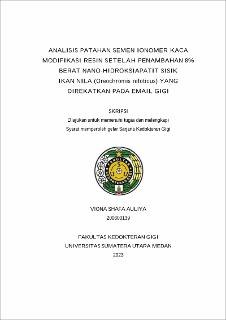| dc.contributor.advisor | Harahap, Kholidina Imanda | |
| dc.contributor.author | Auliya, Viona Shafa | |
| dc.date.accessioned | 2024-02-07T07:31:50Z | |
| dc.date.available | 2024-02-07T07:31:50Z | |
| dc.date.issued | 2023 | |
| dc.identifier.uri | https://repositori.usu.ac.id/handle/123456789/91048 | |
| dc.description.abstract | Resin modified glass ionomer cement is a restorative material that requires
special attention especially on its mechanical properties in order to produce strong
adhesion to the tooth surface. The adhesive strength depends on the adhesive strength
that occurs on the initial substrate (adherend). The strength of the adhesive can be
marked on the type of fracture that occurs after the adhesive strength test is carried out.
Several studies have shown that the addition of hydroxyapatite can increase the
adhesive strength. Nano-hydroxyapatite synthesized from tilapia scales (Oreochromis
niloticus) is an alternative that can be used to improve the mechanical properties of
resin modified glass ionomer cement. Failure to adhere the restorative material to the
tooth surface is divided into cohesive, adhesive, and mixed. The purpose of this study
was to determine the differences and proportions of broken categories of resin modified
glass ionomer cement without the addition of nano-hydroxyapatite and with the
addition of 8% by weight nano-hydroxyapatite tilapia (Oreochromis niloticus) scales
on tooth enamel. This study used samples that had previously been tested for tensile
strength with two test groups, namely group 1 (without the addition of nanohydroxyapatite)
and group 2 (addition of 8% by weight of nano-hydroxyapatite)
(n=10). After testing the tensile adhesive strength, the samples were immersed in
distilled water to keep them moist. Then, observation of the fault was carried out using
a Stereomicroscope and Scanning Electron Microscope (SEM). The results of
observing the fracture of the restorative material on the tooth enamel surface were then analyzed using the Chi-Square (p<0.05). The results of the fracture analysis in group 1
were the mixed failure 8 samples, cohesive failure 1 sample, and adhesive failure 1
sample. In group 2, namely mixed failure 10 samples. It can be concluded that there is
no significant difference in fracture in groups 1 and 2. The best fracture occurred in
group 2 with mixed failure 10 samples. The mixed failure category can occur if the
restoration material can bond well to tooth enamel. The adhesive failure category
indicates that there is less strong bond formed between the restoration material and the
surface of tooth enamel. While cohesive failure shows that the adhesion strength in the
interfacial exceeds the cohesion strength in the substrate of the restoration material or
tooth enamel. | en_US |
| dc.language.iso | id | en_US |
| dc.publisher | Universitas Sumatera Utara | en_US |
| dc.subject | SDGs | en_US |
| dc.title | Analisis Patahan Semen Ionomer Kaca Modifikasi Resin setelah Penambahan 8% Berat Nano-Hidroksiapatit Sisik Ikan Nila (Oreochromis niloticus) yang Direkatkan pada Email Gigi | en_US |
| dc.type | Thesis | en_US |
| dc.identifier.nim | NIM200600139 | |
| dc.identifier.nidn | NIDN0011098205 | |
| dc.identifier.kodeprodi | KODEPRODI12201#Pendidikan Dokter Gigi | |
| dc.description.pages | 66 Halaman | en_US |
| dc.description.type | Skripsi Sarjana | en_US |


